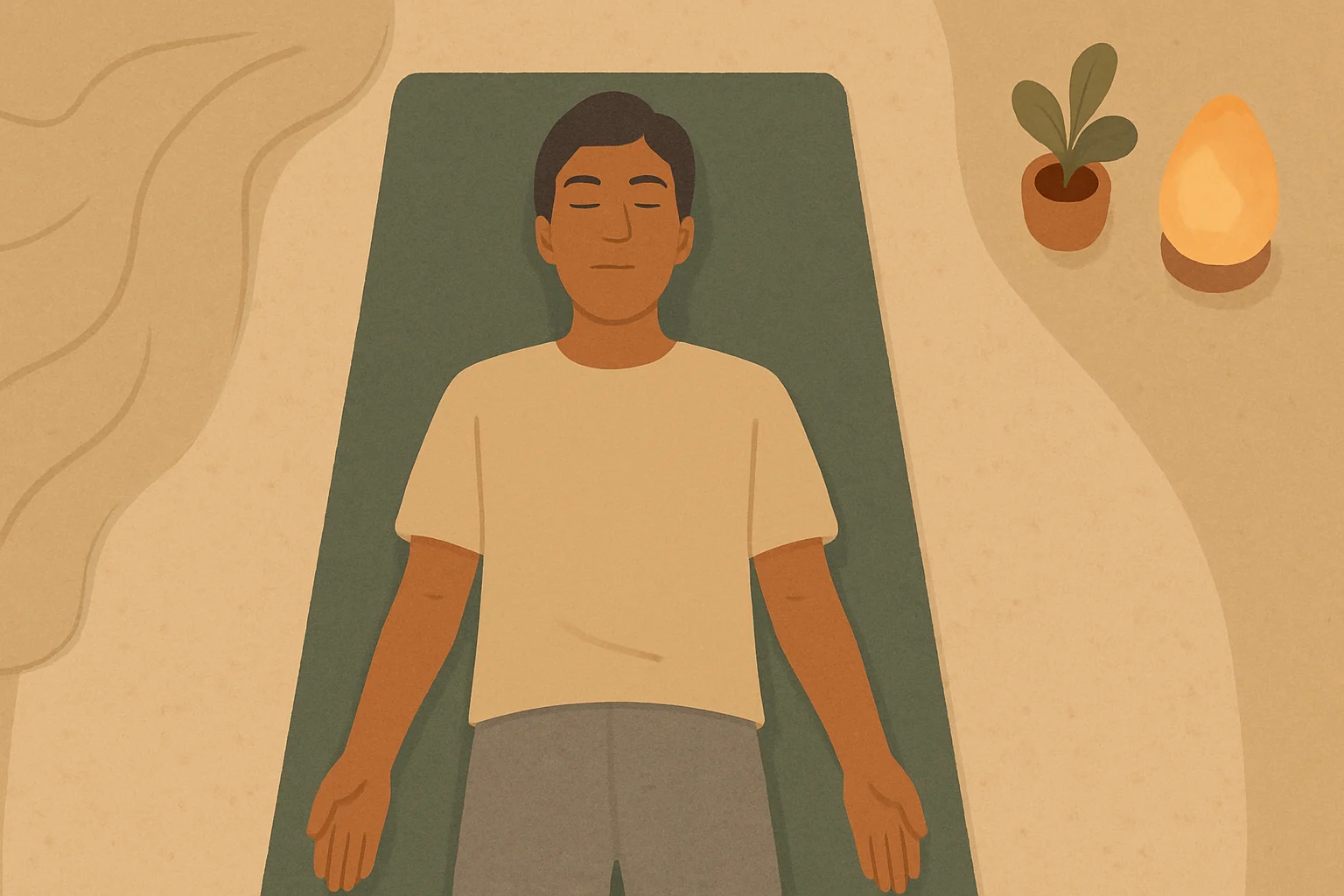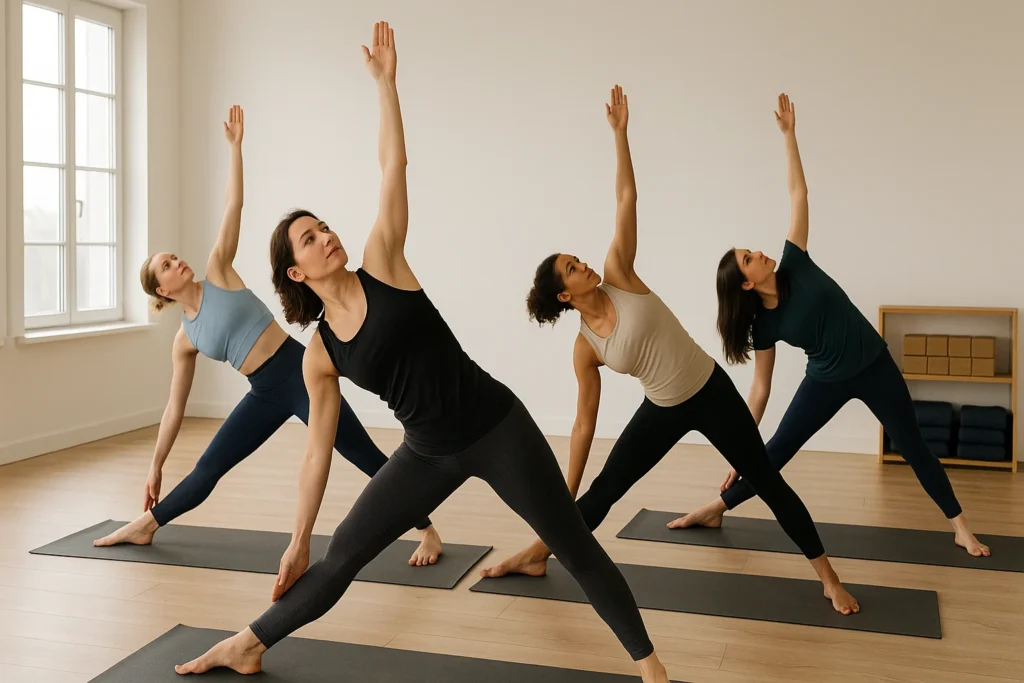
A brief breathing focus may help interrupt a panic spike. These mindfulness techniques for panic attacks can be an anchor to find calm. You can practice simple, supportive tools. To see how these in-the-moment tools fit into a broader mindfulness-based stress practice, explore mindfulness stress relief.
Try the Grounding Tool Now!Table of Contents
Top 5 Mindfulness Techniques for Panic Attacks
- Understand Panic & Mindfulness: Panic attacks are intense bursts of fear, but mindfulness techniques for panic attacks focus your mind on the present, which can help interrupt the fear cycle.
- Immediate Grounding Tools: Techniques like 4-7-8 breathing and the 5-4-3-2-1 sensory method may help calm your nervous system during a panic spike.
- Daily Prevention: Regular practice, like mindful breathing or body scans, may build resilience and reduce panic attack frequency over time.
- Compassionate Recovery: After an episode, treat yourself kindly, rest, and reflect to support healing and learn for the future.
- Empower Yourself: These calming mindfulness practices can help you feel more in control, whether in the moment or as a long-term strategy.
This post has affiliate links. We may earn a commission. Learn more.

What Is a Panic Attack and Why Mindfulness Helps
Imagine you’re walking along, and suddenly, your body sounds the alarm. Your heart races, your breath quickens, and fear surges, even without danger. That’s a panic attack—a sudden, intense wave of fear triggering severe physical reactions. Panic attack mindfulness offers a way to regain a sense of control by staying anchored in the present moment.
Common Symptoms of a Panic Attack:
- Racing Heart: Your heart pounds like it’s escaping your chest. 💓
- Shortness of Breath: You might feel like you can’t breathe. 🌬️
- Chest Pain: A tight, squeezing sensation in your chest.
- Dizziness: Feeling faint or unsteady. 💫
- Trembling: Your body quivers uncontrollably.
- Sweating: Breaking out in a cold or hot sweat. 💧
- Numbness: Tingling in fingers or toes.
- Nausea: A queasy stomach. 🤢
- Detachment: Feeling like you’re outside your body or things aren’t real.
- Fear of Dying: Terrifying thoughts of losing control or dying. 😱
Research suggests mindfulness-based approaches can reduce anxiety symptoms for many people; if panic attacks are frequent, consider speaking with a qualified professional for personalized support (National Institute of Mental Health).
How Mindfulness Techniques for Panic Attacks Work
Mindfulness is the practice of focusing on the present moment without judgment. During a panic attack, your mind may race to scary “what-ifs.” Mindfulness can interrupt this cycle. This present-moment approach is sometimes called panic attack mindfulness.
Why Mindfulness Helps:
- Breaks the Fear Cycle: By focusing on your breath or senses, mindfulness pulls you away from escalating thoughts.
- Calms Your Body: Paced breathing may help activate your parasympathetic nervous system and slow your heart rate.
- Detaches from Thoughts: You learn to observe thoughts as passing clouds, not truths.
- Grounds You: Sensory techniques anchor you in your surroundings, countering detachment.
- Builds Resilience: Regular practice can strengthen your capacity to meet stressful moments.
“Mindfulness isn’t about stopping thoughts; it’s about not letting thoughts stop you.”
Real-Life Mindfulness Techniques for Panic Attacks (Step-by-Step)
When panic hits, you need fast, simple tools. For instance, Sarah, a teacher, stopped a panic episode at work using the 5-4-3-2-1 method. These mindful tools for panic are allies you can use wherever you are.
1. 4-7-8 Breathing: Your Panic-Buster
Your breath is your free, portable panic-buster. The 4-7-8 breathing technique, a commonly used practice within present-moment approaches for panic, may help calm your nervous system. For more breathwork for anxiety, check out our beginner’s guide.
How to Do It:
- Prepare: Sit or lie comfortably. Rest your tongue behind your upper front teeth.
- Exhale: Breathe out through your mouth with a “whoosh” sound.
- Inhale (4 counts): Inhale quietly through your nose for four counts. 👃
- Hold (7 counts): Hold your breath for seven counts. 🤫
- Exhale (8 counts): Exhale through your mouth for eight counts, making a “whoosh.” 🌬️
- Repeat: Complete four cycles.
Why It Works: The long exhale can signal your body to relax by emphasizing the “rest and digest” response.
2. 5-4-3-2-1 Grounding Method
Think of this as a quick sensory check-in that pulls you back to the present. It’s easy to use in public without drawing attention.
How to try it:
- 5 Things You See: Name five things around you (e.g., “blue sky, green tree”). 👁️
- 4 Things You Touch: Feel four textures (e.g., “soft sweater, firm ground”). 👋
- 3 Things You Hear: Identify three sounds (e.g., “birds, traffic”). 👂
- 2 Things You Smell: Notice two scents (e.g., “coffee, rain”). 👃
- 1 Thing You Taste: Note one taste (e.g., “mint toothpaste”). 👅
Why It Works: It redirects your focus from panic to your environment, which can help you feel grounded.

3. Short Body Scan Meditation — Anxiety Relief Practices
A body scan, one of several supportive anxiety relief practices and a helpful mindfulness technique for panic, helps you notice sensations without fear.
How to Do It:
- Find Comfort: Sit or lie down, closing your eyes if safe.
- Breathe: Take a few deep breaths, feeling the air move.
- Scan: Move your attention from head to toes, noticing tension or calm.
- Observe: Don’t judge sensations; just note them.
- Breathe Into Sensations: Direct breath to tense areas, imagining space.
- Widen Awareness: Feel your whole body breathing.
Why It Works: It helps you see sensations as temporary, which can reduce reactivity.
Interactive Tool: Panic Grounding Prompt
This tool tailors mindful grounding to your environment and mood.
Select your location and mood for a personalized grounding exercise.
Preventing Panic with Calming Mindfulness Routines
While these mindful tools can help in the moment, daily calming mindfulness practice can help your nervous system settle over time.
1. Mindful Breathing Throughout the Day
Short bursts of mindful breathing can reset your nervous system.
- Micro-Breaks: Set an alarm every two hours. Take 3-5 deep breaths, noticing the air’s flow. 🌬️
- Transitions: Before starting your car or making coffee, pause for a few breaths.
- Mindful Walking: Feel your feet on the ground and notice sights and sounds.
2. Formal Daily Practice (5-15 Minutes)
Even brief anxiety relief practices can support resilience.
- Guided Meditations: Try apps like Insight Timer for 5-minute anxiety meditations.
- Body Scan: Regular scans help you notice rising anxiety early.
- Loving-Kindness Meditation: Repeat: “May I be happy, healthy, safe, and free from suffering.” Extend to others for self-compassion.
3. Mindful Eating
Mindful eating can be a simple daily anchor. For deeper mindful eating practices, explore our detailed guide.
- Slow down: pause before the first bite and notice color and aroma.
- Engage your senses: chew a little slower and notice texture and flavor.
- No distractions: try one screen-free meal a day.
4. Mindful Movement
Combine movement with present-moment awareness for extra calm.
- Yoga or Tai Chi: These blend breath and movement to reduce stress.
- Stretching: move slowly and notice tension soften on each exhale.
- Nature walks: let your senses do the work—notice the trees, the breeze, and the background sounds.
“Every breath you take is a victory over panic. Show up for yourself daily.”
After the Storm: Recovery Tips Post-Panic Attack
After a panic spike, it’s normal to feel wrung out. The steps below, paired with restorative yoga poses, may help you reset.
1. Practice Self-Compassion
Be kind to yourself—you just faced a storm.
- Acknowledge your strength: “I got through that.”
- Kind self-talk: try, “I’m learning to manage this.”
2. Rest and Recharge
Give your body a little time to reset.
- Sleep: Aim for consistent sleep to support your nervous system.
- Calm activities: read, stretch, or play soothing music.
- Weighted blanket: use it for a bit of grounding comfort.
3. Hydrate and Nourish
Support your body as it settles.
- Water: Sip slowly to rehydrate.
- Light Foods: Choose nutritious, easy-to-digest meals.
4. Journaling and Reflection
Writing can help you process and learn.
- Process: Note what happened and what worked.
- Triggers: Identify patterns to help prevent future attacks.
5. Connect with Support
You don’t have to face this alone.
- Talk: Share with a friend or therapist.
- Professional Help: Consider mindfulness-based cognitive therapy (MBCT) for additional support.
| Recovery Step | Description | Benefits |
|---|---|---|
| Self-Compassion | Treat yourself kindly, use positive self-talk. | Reduces shame, builds resilience. |
| Rest & Recharge | Prioritize sleep, use calming activities or weighted blankets. | Restores energy, supports the nervous system. |
| Hydrate & Nourish | Drink water, eat light foods. | Supports recovery, stabilizes body. |
| Journaling | Write about your experience and triggers. | Processes emotions, tracks progress. |
| Connect with Support | Talk to someone or seek MBCT. | Reduces isolation, offers tailored strategies. |
Frequently Asked Questions About Mindfulness for Panic
Conclusion: Your Path to Calm
Panic attacks can feel overwhelming, but mindfulness techniques for panic attacks give you tools to regain a sense of control. From quick breathing exercises to daily practices, you’re building a calmer, stronger you. Start small, be patient, and keep practicing—you’ve got this. 🌟


